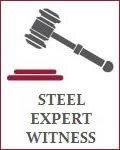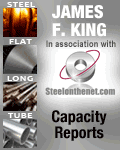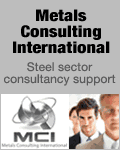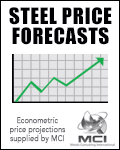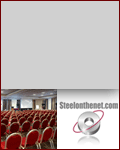Consumption, product mix & substitution.

World Steel Industry Trends.
Global trends in consumption, product mix, substitution
Consumption
Consumption of steel products follows the trend of economic activity in individual countries. There is a clear trend for high levels of consumption of steel products at certain stages of economic development, which are associated with rapid urbanisation and construction, combined with industrialisation and the growth of manufacturing industry.
The urbanisation and construction provide strong demand for steel long products (bars, sections) and some flat products (plate and galvanised sheet for construction), while the growth of manufacturing industry provides demand for flat products (hot- and cold-rolled coil, stainless steel, etc).
As more developing countries pass through this phase, following on a smaller scale the path of China from the mid-1990's onwards, steel demand will increase rapidly in some parts of the world.
The other clear long-term trend is that steel consumption stabilises or starts to fall in relation to GDP at high levels of income per head. This means that there will continue to be slow growth in steel consumption in the developed countries of North America, Western Europe and Japan.
The steel market has a relatively heavy dependence on the automotive and construction sectors. These are among the most cyclically variable of industries. Hence the steel market will continue to experience large cyclical movements in demand and companies need to structure their operations and organisations in order to cope with these fluctuations.
The stage of a country's development determines the mix of steel products consumed. The more advanced industrial economies have relatively high consumption of flat-rolled steel, with more coated products such as galvanised and organic coated steel, relatively high consumption of high-quality long products (engineering or SBQ bar and drawing quality wire rod) and relatively lower consumption of reinforcing bar and simple long products.
As economies mature, the product mix therefore changes over time towards the higher-value and higher-technology products.
This is also influenced by trends within end-use sectors, which may have a stronger impact in certain countries. Trends which can be expected to continue in the period to 2030 include:
- continued growth in galvanised, pre-coated and high-strength lightweight steel used in vehicle bodies
- strong demand for steel plate for wind turbines and alternative energy systems
- strong demand for seamless tube and higher qualities of welded tube for oil and gas exploration, development and transmission in all areas with such resources, but subject to wide cyclical fluctuations depending on the price of oil
- good demand in developing countries for products associated with electricity generation and transmission (e.g. steel light sections for transmission towers)
- good demand in developing countries for steel welded tube for water supply systems
- demand in the USA for plate and heavy sections as part of a programme of infrastructure reconstruction
- short- and medium-term demand in Europe for plate, heavy sections and rail as part of cyclical construction programmes to boost the economy
- above average growth in demand for stainless steel for domestic appliances and power generation
- a continuing shift to higher-performance special steels for engineering, automotive, military and aerospace activities in the developed countries
- high demand for reinforcing bar and construction steel in developing countries or in certain countries with major state-funded economic development and housing programmes (e.g. China, countries of the Middle East)
The issue of product mix also applies to production of semi-finished steel. There is a market for semi-finished steel in the form of slabs, bloom and billets supplied to affiliated rolling mills or to third parties without their own steelmaking capacity. A few plants specialise in this market. For the reasons of raw materials and production costs discussed below it has been expected that there would be a trend towards the separation of the production of crude and semi-finished steel from the rolling and finishing of steel products.
Some movement in this direction has been made, particularly the decision by Thyssen-Krupp in Germany to establish production of slabs in Brazil for export to the company's plants in Europe and the USA. Most products have not moved in this direction, probably because the cost of long-distance transport of semi-finished steel rose after 2005 to the point where the economics seemed marginal.
This trend is itself therefore dependent on developments in the costs of transport.
(In the short term - after 2014 and 2015 - transport costs are likely to be low because of the combination of low oil prices and an excess supply of bulk shipping capacity).
Nevertheless there is scope for more regional trade of this type within major companies, with production of semi-finished steel and rolled steel products at separate plants in the same area. The possibility of a break-up of the industry's structure into companies producing crude and semi-finished steel and independent companies producing rolled products has not developed in flat products.
It remains the case that independent bar rolling mills purchasing billets are likely to be significant in the growth of the steel industry in developing countries with small markets. Sales of billets to this re-rolling industry will probably grow.
The pattern of development within countries will remain as before, with companies installing their own steelmaking and billet capacity (normally a scrap-based electric furnace) when their production of rolled products becomes large enough. Sales of intermediate products will also occur in flat products, where the typical pattern in developing countries is for installation of a galvanising plant to serve the local market, followed by a cold rolling mill, then a hot rolling mill and finally steelmaking and the production of slabs.
The size of the market required for a steelmaking plant for flat products is substantially larger (probably 2 million tonnes) than for a steelmaking plant for long products (probably 500,000 tonnes).
The consumption of materials depends on the volume of activity in relevant end-use applications (e.g. how many cars are built) and the selection of alternative materials. Steel is selected for each application against alternative materials on the basis of a combination of technical qualities and cost. Cost means the cost to the consumer of acquiring and processing steel into the product that he needs.
If steel prices are high, it is clear that users will seek alternative materials with similar technical performance but lower overall cost.
The scope for doing this varies widely between applications. In the short term there is essentially no competitor for steel in its applications in construction, engineering, shipbuilding and much of the automotive or domestic appliance industry. There are potential competing products (other metals, plastics, etc.), but these have all risen in price and do not have the volumes available to take significant market share from steel.
In the longer term it is possible to redesign products to change materials if one is technically or economically superior to another. Price is one factor in this type of decision, but we do not believe that the price of steel is a critical factor in its selection in most applications. Fine comparisons of price against alternative materials are important in certain applications, such as in the manufacture of beverage cans in competition with aluminium.
In other applications stability and predictability of prices is believed to be very important. The price of steel products has been much more stable than that of most metals, but this has not been sufficient to prevent steel losing some markets to other metals in cars.
The factors determining the choice of materials in any individual application seem so complex, however, that it is not correct, in our view, to conclude that changes in the price of steel relative to the price of aluminium or cement or oil (as the feedstock for plastics) can give any practical guide to the likely impact on future demand. In practice materials choices are much more sophisticated than this.
Indeed, it is our impression, from studying the industry over an extended period of time, that movements in prices are much less important than other market changes in determining the trends of consumption. Such other changes include:
- design improvements by user industries (lighter steel beams for buildings or bridges)
- product quality (e.g. reducing the gauge of sheet by technical improvements in rolling)
- new product development (invention of new steel-using products, which have been relatively few)
- marketing developments (exploitation of new steel products, e.g. promoting steel in residential housing)
- government regulations (e.g. mandatory reductions in car weight, imposition of deposit charges on beverage containers).
In 2007 and 2008 prices for steel products reached extraordinary levels, with commodity products selling for over $1000 per tonne compared to previous experience where $400 was considered high. If this price level had continued for a period of over 2 years and if such price rises had not also applied to competing products, this would have had a substantial impact on the design of products and the consumption of steel in the longer term.
This did not happen. Nevertheless, for the reasons outlined above, aluminium continued to gain market share against steel in the automotive market despite its higher cost as a material.
An alternative possibility is that the price of materials, including steel, rise to such an extent that buyers do not use the product because it is too costly. Persistently high steel prices would start to reduce demand in the medium term, since they would make steel-containing products too expensive for consumers - rising car prices will reduce the demand or size of cars; high costs of construction will reduce the demand for new buildings, etc.
In 2008 the impact of the high price of steel was of this type, affecting the decisions of investors to proceed with projects - by making the cost of steel-based construction or manufacture so high that projects were considered uneconomic and did not proceed. The impact was therefore on the volume of demand for all materials and not on the relative demand for steel in relation to competing materials. Since 2008 steel and other material prices have fallen sharply and 'demand destruction' through high absolute prices is no longer an issue.
We do not therefore expect that forecasts for steel consumption would be significantly changed if the prices of steel lie within a fairly wide range similar to normal experience. If prices lie consistently outside the range of recent experience, relative to other materials, changes in the pattern of consumption will occur.
A noticeable impact from substitution of materials is expected only in certain applications in the period to 2030. These are:
- aluminium replacing cold-rolled and galvanised steel in car bodies under pressure from high fuel prices and government fuel consumption targets
- aluminium maintaining or increasing its penetration into beverage cans and perhaps increasing penetration into food cans against tinplate
- continued strong competition between building materials - concrete with steel reinforcement, steel sections with concrete blocks, brick and timber
- plastic pipes replacing cast iron and welded steel in local gas and water distribution.
Some forms of substitution are between steel products. These include:
- stainless steel replacing coated carbon steel in high corrosion applications or for design reasons
- tubes replacing sections in construction steelwork
- tubes replacing fabricated sheet in for structural strength in vehicle bodies
- steel sections replacing with concrete with steel reinforcement in construction of low-rise buildings
- welded tubes replacing seamless tubes in some oil and gas applications.
Steel producers must continuously adapt their product range to these changes in patterns of demand within and between countries.
To contact us about this steel industry demand trends page please email info@steelonthenet.com.
